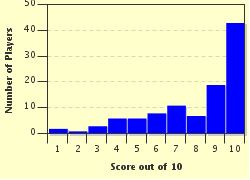Quiz Answer Key and Fun Facts
1. Solar power can make life easier in remote locations that don't have access to electricity grids, and in some cases, it serves a vital purpose. For which of the following is solar power most commonly used in rural locations?
2. These buildings are often among the first in a remote community to receive off-grid solar energy systems. Besides being used for traditional operations during the day, solar energy can be stored in batteries which allow the buildings to be used as community centers after dark. In which buildings can people be taught about the uses of solar power?
3. The processing of this major export product requires significant energy and has contributed to the destruction of the rainforest as trees are felled to supply power. To prevent the use of wood, solar energy devices are now being used in Latin America for which of these purposes?
4. Solar power has brought educational opportunities to children in developing nations around the globe by providing them with equipment that is common in schools in industrialized nations. What solar-powered items are they?
5. This most basic of appliances is costly to operate in remote locations. Fuel for it must either be gathered, taking significant time, or must be purchased. Instead of using traditional fuels, which essential appliances are now being run on solar power?
6. One of the main problems in developing nations is the spread of disease. Which solar-powered devices use evaporation and UV radiation processes to remove disease-causing agents?
7. Kerosene is often used as a fuel source in the developing world, but it is not the best choice. Not only is it expensive, it can be dangerous, causing fires and injuries. Which basic devices, traditionally run on kerosene in rural areas, are increasingly operated by solar power?
8. While most solar applications in developing nations are geared towards basic living needs, this one brings people into the 21st century. What solar-powered, high-tech devices have been installed on rooftops?
9. While solar-powered refrigerators exist, the cost is fairly prohibitive to use them for food storage. However small-scale models are now showing up in rural areas. For what purpose are these mini refrigerators intended?
10. These devices are now practically a necessity world-wide, but people in rural or developing areas often have problems getting them charged; either electricity isn't available, or it is too expensive. For which high-tech devices are solar-powered models popular in rural areas?
Source: Author
PDAZ
This quiz was reviewed by FunTrivia editor
crisw before going online.
Any errors found in FunTrivia content are routinely corrected through our feedback system.

